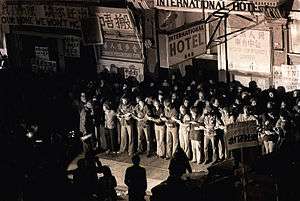Eviction in the United States
The procedure and rate of eviction in the United States varies by locality. Landlord-initiated expulsion of tenants is not officially tracked or monitored by the Federal government, and has historically not been subject to comprehensive analysis. The 2016 publication of the book Evicted: Poverty and Profit in the American City by Matthew Desmond raised awareness of the issue. A database created by Desmond found that landlords had been granted eviction notices for one in 50 renter households in analyzed regions. This rate only counts evictions that engage the legal process, as many evictions are informally conducted between landlords and renters, it likely undercounts actual evictions.[1]

Causes
Most evictions in the United States occur because the tenant cannot or will not pay rent. Landlords can also expel tenants for breaking the law, damaging property, sub-leasing, or causing a disturbance. In most American municipalities, tenants who haven't violated their lease can be expelled, in what is known as "no-fault evictions."[2]
Most renting families under the poverty line spend more than 50% of their income on rent, with one in four such families spending over 70% of their income on rent and utilities. About one in four low-income renters receives housing assistance.[2] Eviction rates are higher in communities with multiple aggravating factors, including high levels of poverty. These include local laws that give advantage to landowners and a lack of available affordable housing that would increase market pressures to keep rents low.[1]
When housing pressures are extreme, even middle-class and working class renters are evicted by landlords eager to capitalize on the rising market rates, such as in San Francisco during the various tech booms. In such circumstances, landlords may seize upon minor violations that were previously tolerated, such as keeping a small pet or storing a bicycle in the hallway, to evict renters. The situation in California is aggravated by the Ellis Act, which allows landlords to evict tenants and immediately sell the vacant apartments as condominiums.[3]
Evictions disproportionately affect low-income women, in particular women of color.[2] Approximately one in five African-American women renters report being evicted as some point in their life, while the equivalent rate for white women renters is one in 15.[4] Victims of domestic violence and families with children are also at high risk of eviction.[2] Renters who appear in eviction court are three times more likely to actually be evicted if they live with children.[4]
Consequences

Eviction is a cause of poverty, as well as a result of it. The loss of home often results in the loss of community connections, as well as children being forced into a new school. Possessions are routinely lost, as they are placed outside on the sidewalk or placed in storage that can only be accessed by paying a fee. A legal eviction typically goes on the permanent record of the boarder, resulting in automatic rejection by other landlords or housing authorities.[2]
Persons who are evicted lose their jobs at higher rates, either because of the new stress or because the job is no longer easily accessible in a new residence. Mental health often suffers, with one study finding that evicted mothers reported higher rates of depression two years after being expelled.[2]
Rates and locations
There is no government reporting system on eviction, so variance by location and time were, at best, little understood and, at worst, invisible. This began to change with the implementation of Princeton University's Eviction Lab which published the results of an analysis of 900,000 eviction notices that occurred in 2016.[1]
.jpg)
.jpg)

| Rank | City | Eviction Rate |
|---|---|---|
| 1 | North Charleston, South Carolina | 16.5% |
| 2 | Richmond, Virginia | 11.44% |
| 3 | Hampton, Virginia | 10.49% |
| 4 | Newport News, Virginia | 10.23% |
| 5 | Jackson, Mississippi | 8.75% |
| 6 | Norfolk, Virginia | 8.65% |
| 7 | Greensboro, North Carolina | 8.41% |
| 8 | Columbia, South Carolina | 8.22% |
| 9 | Warren, Michigan | 8.08% |
| 10 | Chesapeake, Virginia | 7.9% |
Eviction laws and policies
Eviction laws in the United States vary by jurisdiction, and are based on state statute and common law.[6]
Eviction and the COVID-19 pandemic
During the COVID-19 pandemic in the United States, mass job loss and unemployment led to fears of mass evictions as tenants became unable to pay rent. An analysis by the Aspen Institute indicated between 19-23 million, or 1 in 5 renters, are at risk for eviction by the end of September, 2020;[7] a separate July 2020 analysis projects 16 million households unable to pay rent and at risk of eviction, with a potential 11 million eviction filings in the next four months.[8]
In response, the federal CARES Act included an eviction moratorium for federally-backed rental properties; however, this expired on July 24,[9] and no enforcement mechanism was provided.[10] States and cities also passed a variety of temporary eviction moratoriums.[11][12][13] As these moratoriums expire over the course of 2020, there were fears of a massive wave of evictions; by mid-June 2020, over 40% of states offered renters no protections.[14]
See also
| Wikimedia Commons has media related to Eviction in the United States. |
References
- Badger, Emily; Bui, Quoctrung (2018-04-07). "In 83 Million Eviction Records,a Sweeping and Intimate New Look at Housing in America". The New York Times. Retrieved 2018-04-16.
- "Why Eviction Matters". Eviction Lab. Princeton University. 2018-04-16. Retrieved 2018-04-16.
- Christie, Les (2014-10-29). "Rents are soaring -- and so are evictions". CNN Money. Retrieved 2018-04-16.
- White, Gillian B. (2016-04-01). "America's Insidious Eviction Problem". The Atlantic. Retrieved 2018-04-16.
- "Top Evicting Large Cities in United States, Ranked by Eviction Rate". Eviction Lab. Princeton University. 2018-04-16. Retrieved 2018-04-16.
- "Landlord-Tenant Law". LII / Legal Information Institute. Retrieved 2020-07-19.
- "20 Million Renters Are at Risk of Eviction; Policymakers Must Act Now to Mitigate Widespread Hardship". The Aspen Institute. 2020-06-19. Retrieved 2020-07-11.
- Stout Risius Ross LLC. "Estimation of Households experiencing rental shortfall and potentially at risk of eviction". https://www.stout.com/en/services/transformative-change-consulting/eviction-right-to-counsel-resources. Retrieved 2020-07-22. External link in
|website=(help) - "Foreclosure and Eviction Moratoriums Under the CARES Act". The National Law Review. Retrieved 2020-07-19.
- Ernsthausen, Jeff; Simani, Ellis; Elliott, Justin. "Despite Federal Ban, Landlords Are Still Moving to Evict People During the Pandemic". ProPublica. Retrieved 2020-07-26.
- Shaw, Al; Simani, Ellis; Ernsthausen, Jeff; ProPublica; May 18; June 29, 2020 Updated; 2020. "Can I Be Evicted During Coronavirus?". ProPublica. Retrieved 2020-07-19.CS1 maint: numeric names: authors list (link)
- Lab, Eviction. "COVID-19 Housing Policy Scorecard". Eviction Lab. Retrieved 2020-07-26.
- O’Connell, Ann; Attorney. "Emergency Bans on Evictions and Other Tenant Protections Related to Coronavirus". nolo.com. Retrieved 2020-07-26.
- "Why US is expecting an 'avalanche' of evictions". BBC News. Retrieved 2020-07-19.
External links
- Eviction Lab from Matthew Desmond at Princeton University—a nationwide database of evictions